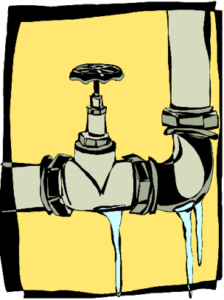Managing the Leaky Pipes in your Investment Portfolio
This article outlines the concept of relating leaky pipes to chronic under-performing stocks in your investment portfolio.

Leaky pipes do their damage over time, in that a small leak may not appear to be a big problem. However, the damage caused might remain undetected for years. These slow, long-term leaks can result in much more damage than a burst pipe. Why? In the case of a burst pipe, you’ll be immediately aware of problem, and can shut off the water supply. Then limiting the damage to a more isolated area.
For investors, a leaky pipe is similar to a chronic under-performing stock. These under-performing stocks rarely grab our immediate attention. This is because there may not be any immediate dramatic dips in performance. Instead, just a steady downward trend. ‘Leaky’ stocks have the potential to do the most long-term damage. Likewise, a burst pipe is similar to a volatile headline grabbing company. Such companies draw immediate attention, and often have a dramatic dip in share price. Most investors act quickly to limit the appreciable impact over the life of their portfolio.
There is great importance of recognizing ‘leaky pipes’ since these investments create damage that is hard to recover. While these leaky pipes might have been stock market darlings of the past, investors must overcome the difficulty of jettisoning these former winners. Investors must move past the belief that the ‘return to glory’ days are just around the corner. Otherwise, by continuing to hold these ‘leaky pipes,’ performance leaks out year after year, and the performance returns required to catch-up become greater and greater. Further, a leaky pipe may be taking up a place in portfolio that can be replaced by out-performer – there is an opportunity cost lost by not replacing.
So, what’s an investor to do to better manage/identify leaky pipes? First, start by organizing your investment holdings. Once organized, properly measure the long-term performance of your holdings to see if they are meeting your required thresholds. Be sure to monitor fundamental trends, staying up to date on key financial metrics, and verifying these metrics are consistent for long-term performance. Maintain a watch-list of ideas for replacement candidates. Once a holding(s) is identified as a ‘leaky pipe’, replace from your watchlist to improve long term results.
In summary, investors are too tolerant of leaky pipes, and instead need to adopt a process to be actively searching for and eliminating leaky pipes in their portfolios. By not doing so, leaky pipes will cause underperformance, while also taking the place of potential position that could generate outperformance for long-term success.
Investment Account Manager provides the tools to identify leaky pipes in your portfolio, and allows you as the manager of your portfolio, to measure and improve the long term performance of your portfolio, while adhering to the guidelines that meet your risk tolerance.
References: Wachovia Securities (Wells Fargo Advisors)